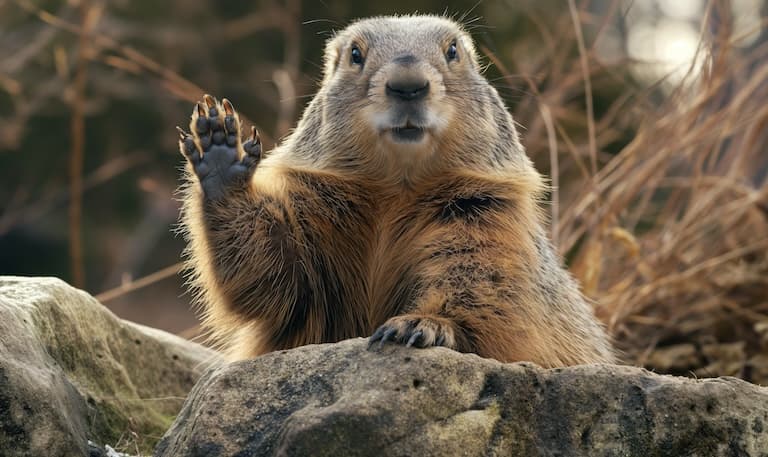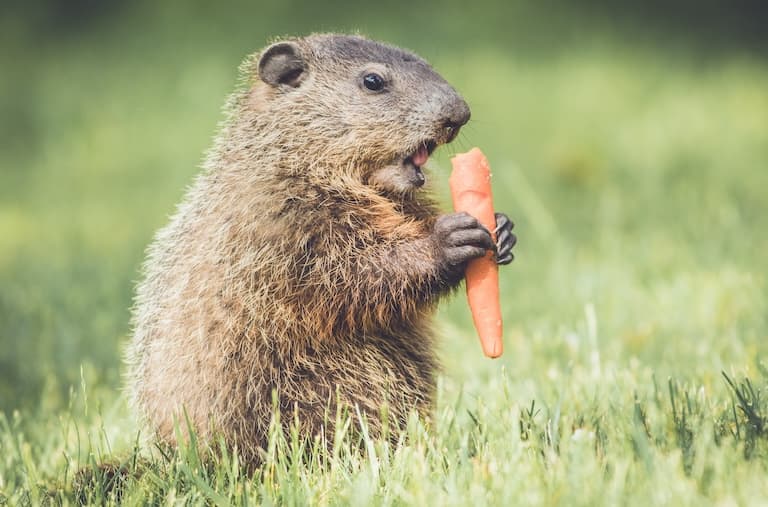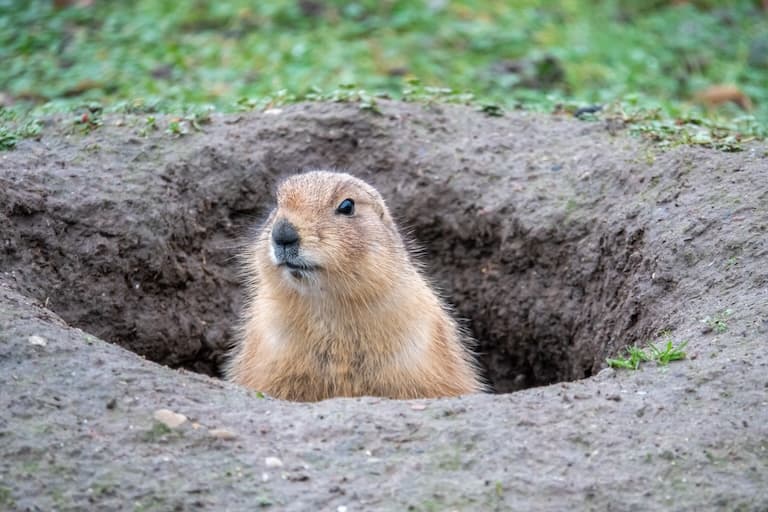Groundhog Profile
There’s an old tongue-twister that goes something like,
“How much ground could a groundhog hog if a groundhog could hog ground? A groundhog would hog as much ground as a groundhog could hog if a groundhog could hog ground”.
It’s not a good rhyme, but it is a testament to the tenacity of one of the largest squirrels in North America. And while they don’t hog the ground as such, they do chuck a substantial amount of it.

Groundhog Facts Overview
| Habitat: | Lowland, fossorial |
| Location: | North American plains |
| Lifespan: | Up to 6 in the wild, possibly 14 in captivity. |
| Size: | Up to 65 cm (27 in) long |
| Weight: | Up to 6.5 kg (14 lb) |
| Colour: | Grey to brown to reddish brown |
| Diet: | Grasses, berries, bark, leaves, and agricultural crops |
| Predators: | Coyotes, badgers,[69] bobcats, and foxes, wolves, cougars, raptors |
| Top Speed: | Slow, possibly 13 km/h (8 mph) |
| No. of Species: | 1 |
| Conservation Status: | Least Concern (IUCN) |
Groundhogs, also often known as woodchucks, don’t chuck wood and instead spend their lives digging holes in the earth. These impressive burrows change the landscape entirely, which is great for the ecosystem but not so good for farmers who are trying to grow things in it and consider them a pest.
As such, they’ve been persecuted to a great degree and are one of the most infamous critters on the American plains. But really, they’re just a big fat squirrel trying to make ends meet.
Interesting Groundhog Facts
1. They’re called everything
Along with the well-known woodchuck nickname, groundhogs can go by any of the following: a wood-shock, groundpig, whistlepig, land beaver, red monk, moonack, thicketwood badger, weenusk, monax and whistler.
There are more, but this blog has a word limit.
It’s safe to say though, that none of these names accurately describes the poor thing, which is likely something a lot more familiar than many realise.
2. But they’re squirrels
We typically consider squirrels to be sprightly, bushy-tailed arboreal acrobats often found on bird feeders or burying acorns in the grass, but there’s a whole branch of the squirrel family dedicated to a more fossorial, or burrowing lifestyle.
These are aptly named the ground squirrels, though out of all the common names given to them, you would be forgiven for thinking they’re anything but squirrels. Groundhogs aren’t hogs, badgers, beavers or pigs, they’re squirrels: rodents from the family Sciuridae, and more specifically, marmots, from the Marmota genus.
Marmots are some of the largest squirrels you’ll find, and groundhogs are the biggest in their range, which spans the eastern and central United States northward across Canada and into Alaska. They grow to over 6kg in weight, and this makes them ineligible for the arboreal lifestyle, so they choose to dig, instead.

3. They’re not very social
Groundhogs are some of the most solitary squirrels, though they’re tolerant of others. Dominant males will have a range of around 10,000m2 and defend it against overlapping individuals when necessary.
Most of the time, subordinates live around the same area without any issues, but if there is a conflict, arched backs, barking, bared teeth and raised tails will ensue.
Being so tolerant of one another means there can be a lot of burrows in the same area. They’ll dig a separate burrow for over-wintering, in which they will hibernate from October to around March, or until some strange guy in a hat pulls them out for a weather forecast (more on that later). 1

4. They hog a lot of ground
The woodchuck misnomer has been tackled in the context of just how much ground they can move. A typical groundhog burrow is around nine metres long, and accounts for anything between 175 kg to 290 kg of earth moved.
One curious worker from the US Fish and Wildlife Service estimated that this would be the equivalent of around 317 kg of wood, if the volume was kept the same, meaning that if a woodchuck could chuck wood, this is about the amount it would.
These squirrels aren’t really social, as such, but they will dig burrows next to one another and sometimes even share one. All this ground-hogging unsurprisingly affects the entire ecosystem around them. 2
5. This changes the ecosystem
Most marmots, or ground squirrels, live in rocky outcrops, but the groundhog is an unusual exception in that it prefers the lowland soils into which it can dig.
This digging aerates and drains the soils, adds fertiliser, recycles nutrients and creates habitats for plant and animal species, and so this single species is an ecosystem engineer, responsible for the wellbeing of multiple other species around it.
Sadly, there’s one species that doesn’t particularly appreciate this.
6. And causes problems for farmers
Digging is already one of the things farmers hate, but groundhogs will also eat a lot of the crops grown, which doubles the vilification forces aimed at them by agriculturalists.
Burrowing can even undermine the foundations of buildings, causing a health hazard, and the burrows can become home to other crop pests such as rabbits.
But foxes are a crop farmer’s friend, so in some instances, they’re encouraged to occupy groundhog burrows to not only keep out the offenders but also help keep other pests like mice and rats out and protect the food crop.
But in other cases, the groundhogs themselves become the meal.

7. They’re sometimes eaten
Groundhog Day means many things to many people. For some growing up in the ‘90s, it’s the day Bill Murray got to sleep with Andie MacDowell over and over and over again.
For others, it’s the day that a crowd gathers around the irredeemably-named Gobbler’s Knob to get a weather forecast from a confused squirrel pulled out of a box, and for others still, it represents a time to honour the woodchuck by baking it into a pie.
The 2nd February is a tradition that some have come to take as seriously as Thanksgiving, though, in place of the turkey, there’s a rudimentary form of pest control in the form of a groundhog feast. 3 4
Groundhog Fact-File Summary
Scientific Classification
| Kingdom: | Animalia |
| Phylum: | Chordata |
| Class: | Mammalia |
| Order: | Rodentia |
| Family: | Sciuridae |
| Genus: | Marmota |
| Species: | Monax |
Fact Sources & References
- “Marmota monax woodchuck”, Animal Diversity Web.
- BBC Wildlife Magazine (2024), “How much wood could a woodchuck chuck?”, Animal Diversity Web.
- Everett J. Castro (2024), “How To Cook Groundhog”, Mother Earth News.
- Stam M. Zervanos (2010), “Latitudinal Differences in the Hibernation Characteristics of Woodchucks (Marmota monax)”, The University of Chicago Press Journals.
